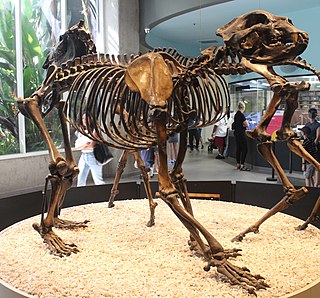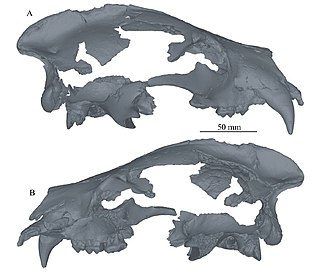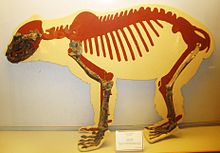
Bears are carnivoran mammals of the family Ursidae. They are classified as caniforms, or doglike carnivorans. Although only eight species of bears are extant, they are widespread, appearing in a wide variety of habitats throughout most of the Northern Hemisphere and partially in the Southern Hemisphere. Bears are found on the continents of North America, South America, and Eurasia. Common characteristics of modern bears include large bodies with stocky legs, long snouts, small rounded ears, shaggy hair, plantigrade paws with five nonretractile claws, and short tails.

The brown bear is a large bear species found across Eurasia and North America. In North America, the populations of brown bears are called grizzly bears, while the subspecies that inhabits the Kodiak Islands of Alaska is known as the Kodiak bear. It is one of the largest living terrestrial members of the order Carnivora, rivaled in size only by its closest relative, the polar bear, which is much less variable in size and slightly bigger on average. The brown bear's range includes parts of Russia, Central Asia, the Himalayas, China, Canada, the United States, Hokkaido, Scandinavia, Finland, the Balkans, the Picos de Europa and the Carpathian region, Iran, Anatolia, and the Caucasus. The brown bear is recognized as a national and state animal in several European countries.

The Stone Age was a broad prehistoric period during which stone was widely used to make stone tools with an edge, a point, or a percussion surface. The period lasted for roughly 3.4 million years and ended between 4,000 BC and 2,000 BC, with the advent of metalworking. Though some simple metalworking of malleable metals, particularly the use of gold and copper for purposes of ornamentation, was known in the Stone Age, it is the melting and smelting of copper that marks the end of the Stone Age. In Western Asia, this occurred by about 3,000 BC, when bronze became widespread. The term Bronze Age is used to describe the period that followed the Stone Age, as well as to describe cultures that had developed techniques and technologies for working copper alloys into tools, supplanting stone in many uses.

The American black bear, also known as the black bear, is a species of medium-sized bear endemic to North America. It is the continent's smallest and most widely distributed bear species. The American black bear is an omnivore, with its diet varying greatly depending on season and location. It typically lives in largely forested areas, but will leave forests in search of food, and is sometimes attracted to human communities due to the immediate availability of food.

A pika is a small, mountain-dwelling mammal native to Asia and North America. With short limbs, a very round body, an even coat of fur, and no external tail, they resemble their close relative, the rabbit, but with short, rounded ears. The large-eared pika of the Himalayas and nearby mountains lives at elevations of more than 6,000 m (20,000 ft).

The Palearctic or Palaearctic is the largest of the eight biogeographic realms of the Earth. It stretches across all of Eurasia north of the foothills of the Himalayas, and North Africa.

The cave bear is a prehistoric species of bear that lived in Europe and Asia during the Pleistocene and became extinct about 24,000 years ago during the Last Glacial Maximum.

The sun bear is a species in the family Ursidae occurring in the tropical forests of Southeast Asia. It is the smallest bear, standing nearly 70 centimetres at the shoulder and weighing 25–65 kilograms. It is stockily built, with large paws, strongly curved claws, small rounded ears and a short snout. The fur is generally jet-black, but can vary from grey to red. The sun bear gets its name from its characteristic orange to cream-coloured chest patch. Its unique morphology—inward-turned front feet, flattened chest, powerful forelimbs with large claws—suggests adaptations for climbing.

The Asian black bear, also known as the Asiatic black bear, moon bear and white-chested bear, is a medium-sized bear species native to Asia that is largely adapted to an arboreal lifestyle. It lives in the Himalayas, southeastern Iran, the northern parts of the Indian subcontinent, the Korean Peninsula, China, the Russian Far East, the islands of Honshū and Shikoku in Japan, and Taiwan. It is listed as vulnerable on the IUCN Red List, and is threatened by deforestation and poaching for its body parts, which are used in traditional medicine.

The water opossum, also locally known as the yapok, is a marsupial of the family Didelphidae. It is the only living member of its genus, Chironectes. This semiaquatic creature is found in and near freshwater streams and lakes from Mexico through Central and South America to Argentina and is the most aquatic living marsupial. It is also the only living marsupial in which both sexes have a pouch. The thylacine, commonly referred to as the Tasmanian tiger, also exhibited this trait, but it is now extinct.

Agriotherium is an extinct genus of bears whose fossils are found in Miocene through Pleistocene-aged strata of North America, Eurasia, and Africa. This long-lived genus persisted from at least ~11.6–2.5 Mya. Materials from the late-surviving A. africanum in Africa have suggested that A. africanum died out during the early Gelasian.

The cave hyena, also known as the Ice Age spotted hyena, was a paleosubspecies of spotted hyena in Eurasia, which ranged from the Iberian Peninsula to eastern Siberia. It is one of the best known mammals of the Ice Age and is well represented in many European bone caves. The cave hyena was a highly specialised animal, with its progressive and regressive features being more developed than in its modern African relative. It preyed on large mammals, and was responsible for the accumulation of hundreds of large Pleistocene mammal bones in areas including horizontal caves, sinkholes, mud pits and muddy areas along rivers.

Arctodus is an extinct genus of short-faced bear that inhabited North America during the Pleistocene. There are two recognized species: the lesser short-faced bear and the giant short-faced bear, also known as the bulldog bear. Both species are relatively rare in the fossil record. A. pristinus was largely restricted to the Early Pleistocene of the Eastern United States, whereas A. simus had a broader range, with most finds being from the Late Pleistocene of the United States, Mexico and Canada. A. simus evolved from A. pristinus, but both species likely overlapped in the Middle Pleistocene. Of these species, A. simus was larger, is known from more complete remains, and is considered one of the most charismatic of North America's megafauna.

Ursus deningeri is an extinct species of bear, endemic to Eurasia during the Pleistocene for approximately 1.7 million years, from 1.8 to 0.1 million years ago.

Ursus etruscus is an extinct species of bear, endemic to Europe, Asia and North Africa during the Pliocene through Pleistocene, living from ~5.3 million to 100,000 years ago.

Stephanorhinus is an extinct genus of two-horned rhinoceros native to Eurasia and North Africa that lived during the Pliocene to Late Pleistocene. Species of Stephanorhinus were the predominant and often only species of rhinoceros in much of temperate Eurasia, especially Europe, for most of the Pleistocene. Two species of Stephanorhinus – Merck's rhinoceros and the narrow-nosed rhinoceros – persisted into the last glacial period.
Villafranchian age is a period of geologic time spanning the Late Pliocene and Early Pleistocene used more specifically with European Land Mammal Ages. Named by Italian geologist Lorenzo Pareto for a sequence of terrestrial sediments studied near Villafranca d'Asti, a town near Turin, it succeeds the Ruscinian age, and is followed by the Galerian.

The small Sirgenstein Cave, German: Sirgensteinhöhle is situated 565 m (1,854 ft) above sea level inside the 20 m (66 ft) high Sirgenstein, a limestone rock. The cave sits 35 m (115 ft) above the Ach River valley bottom in the central Swabian Jura, southern Germany. Archaeologist R. R. Schmidt excavated the site in 1906 during which he identified indices of prehistoric human presence. He recorded the complete stratigraphic sequence of Palaeolithic and Neolithic origin. In his 1910 analysis Schmidt inspired future archaeologists with his pioneering concept of including the excavation site within its geographic region, contextualizing it within a wide scientific spectrum and demonstrated valuable results as he correlated the Sirgenstein layer structure to those of prehistoric sites in France. Mammoth ivory beads dating from 39,000 to 35,000 years ago have been uncovered at the cave. Because of its historical and cultural significance and its testimony to the development of Paleolithic art, the cave was inscribed on the UNESCO World Heritage List as part of the Caves and Ice Age Art in the Swabian Jura site in 2017.
Ursus ingressus is an extinct species of the family Ursidae that lived in Central Europe during the Late Pleistocene. It is named after the Gamssulzen Cave in Austria, where the holotype of this species was found.

Protarctos is an extinct genus of basal ursine bear that lived in North America and Eurasia during the Pliocene and into Early Pleistocene.


















